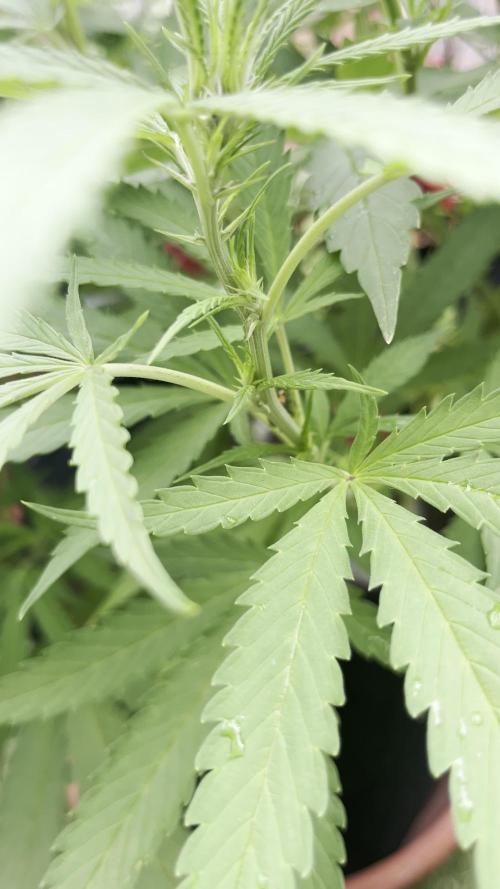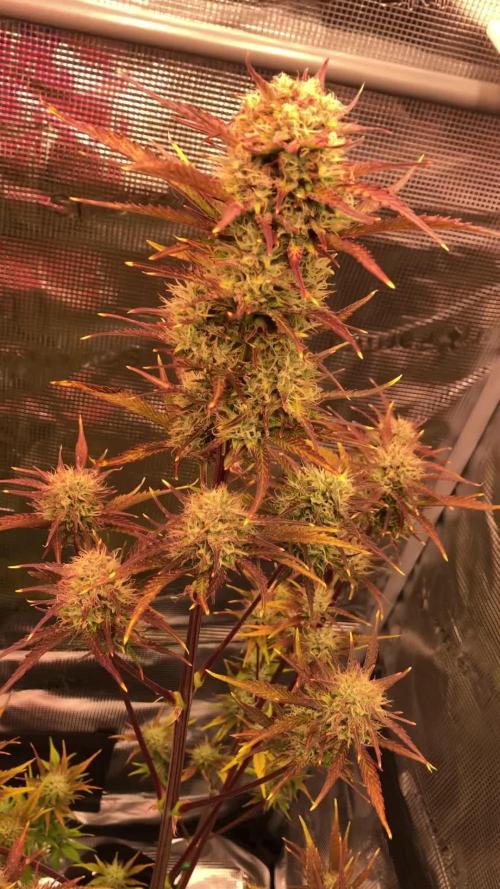The Grow Awards 2026 🏆 





































Likes
Comments
Share


@zera1337
Follow
Week 4:
I somehow managed to overwater 2 of my cuties. Having a humidifier + the fan not being properly positionend kinda lead to this. However, they are now looking stronger again and back on track.
Likes
70
Share


@MrJones
Follow
Sky Walker
~~~~~INDOOR~~~~~
DAY 141 Above Dirt
💬SUNDAY 01.13.24 - So this is the update that I did not have time to do over the weekend, the girls are bouncing back from the hard time I put them through last week, and the flowers are starting to chunk up along with more foliage, however, there will be no more defoliation until we are close to completion, for now, its just water, and wait, allowing the Gaia Green to do its thing, the light is at 100% and the girls love it.
~~~~~~~~~~~~~~~
🌱Sky Walker
👨🌾🏽Sativa Jones
🌤️@Medicgrow420
SeedBank Seeds
📝@gaiagreenorganics
📝Bokashi Biochar
~~~~~~~~~~~~~~~
📝 Skywalker OG Strain is a top-shelf Indica dominant hybrid. It is a cross of Original Amsterdam Blueberry, OG Kush, and the indica strain Mazar from Afghanistan, and is best known for its super potent effects and sky-high THC levels.
Likes
24
Share


@Purrple_Haze
Follow
Stretch Season Approaching? 🌇 | RHC Enters Preflower Elegantly
A fresh update from the balcony garden! My Red Hot Cookies photoperiod has officially entered preflower—a beautiful turning point in the season and a clear sign she’s gearing up for the stretch ahead. 🌀🌿
After some intense vegetative growth, she’s responded well to topping and training, with her canopy now standing tall and open, ready for the sun to do its magic. Her stature is becoming more impressive by the day, and the signs of preflower are clearly visible in the latest close-ups and video. 📸✨
Even nature’s allies came to inspect this week—a little ladybug made an appearance during filming and decided to hang out for a bit. 🍀🐞 Always a good omen in the garden!
This Week’s Care Routine:
🔸 BioBizz Grow – 4 ml/l for steady veg support
🔸 CalMag – 0.5 ml/l to keep her strong and balanced
🔸 Dechlorinated Tap Water – always rested for 24h before use
🔸 Homebrewed Compost Tea – full of life and microbe support
🔸 Effective Microorganisms – boosting soil vitality
🔸 pH: 6.4
🔸 EC: 1800 µS
She’s in a strong spot—tall, healthy, vibrant, and showing no signs of slowing down. I’m genuinely excited to see how she stretches from here and how the first buds begin to develop under the late summer sun. The season is still full of promise, and I’ll keep sharing the journey. 🌞🌱
Stay tuned—there’s still so much more to come!
Likes
2
Share


@AZTERPHUNTER
Follow
Giving another week didn’t realize these would go so long. I freeze-dried a couple top cola of each pheno to get a better profile on them Terps.
Processing
Likes
62
Share


@DudeGrowsWeed
Follow
Welcome to the 2018/19 indoor grow season!!! I am starting this diary for all current seedlings and clones I have started. I'll also be doing separate diaries for some strains individually (but not all).
So, currently I'm about a week in on average with these seedlings and clones. The Seedsman CBD Cream & Cheese and DinaMed CBD+ were started a few days earlier and started stretching using only the 18w T5 my humidity dome came with. So I set up one of my LED's over the humidity dome instead. So far that seems to be helping the newer seeds from stretching too high. I'm also seeing some burn on some girls, I guess the soil must be too hot. I started to try to flush through with straight ph'ed water, but then I started seeing signs of overwatering (rookie mistake, I know). Now I'm just trying to keep a little water on the bottom tray so it generates some humidity in the dome. There's also a heat mat under the tray I have the heat mat on a timer also, 30 min on/30 min off cycling all day. It seemed to get too hot on 24/7.
I'll be transplanting and moving to my 2'x4' tent in about a week. They will live there during veg, then I'll be moving to a 4'x8' tent (not purchased yet) for flower. I'm also planning on adding some COB LED's in the flower tent. Then I'll dedicate my 2x4 tent to mothers, clones and seedlings.
Its going to be a little different this season with both photo period and autoflowering strains going at the same time. But I'm looking forward to it! 👍
Stay tuned...
Likes
18
Share


@ljack494
Follow
Well well well, what do we have here what a good crop so far. The discolored plant had some calcium deficiency so I upped calmag plus 2tps look like it did the trick so everything is good now!
Likes
4
Share


@L8bloomr1008
Follow
Day 49- This week I think we cut out the nutes and let them finish, atleast for the mbrxgp. The Pablo’s revenge looks to be about a week or so behind so we’ll go until they’re finished. Smells on the mbrxgp is heavy citrus, lemon almost, slight gas. Pablo’s are very earthy, I’m expecting a hashy, dank finish for them.
Likes
6
Share


@CanarianGrow92
Follow
Another week flowering for our creepers, at the moment everything looks fine! Next week we will add some extra PK!!
Wonderful strain, but i didn't expect less from the super sativa seeds club!
The flowers are showing a nice pink color very beautiful ❤️
Likes
12
Share


@CanadianFillmore
Follow
Welcome growfessors to the harvest of Green Crack! This strain has been a pleasure to grow, very hearty strain, small and compact during veg then a nice stretch in bloom. Sticky dense buds, strong fuel smell with an underlying sweet aroma.
Will update in 2 weeks with the initial smoke report and dry weight.
Update April 30 - dry weight of 155 grams. Buds are big but not as dense as the LSD buds.
Initial smoke report, earthy tones with a bit of fuel.
Likes
28
Share


@Master_weeda
Follow
Bonjour à tous les padawans et maîtres jedis
Pour la germination j'utilise la technique du sopalin
Pour faire germer vos graines dans du sopalin, vous aurez besoin :
Un Tupperware avec couvercle
Du Sopalin, ou autre quel papier de cuisine qui soit épais et qui retienne l’eau
Un verre d’eau
Si c’est l’hiver, vous placerez le Tupperware près d’une Box ou d’un Modem pour donner un peu de chaleur
Étapes de la germination:
faire germer vos graines de cannabis dans du sopalin
La première chose à faire est de tapisser le fond du Tupperware avec du sopalin, 2-3 feuilles suffiront. Si vous ne mettez qu’une feuille, elle captera peu d’eau et pourra sécher, vous mettrez donc plus de feuilles que pas assez.
Une fois les feuilles placées, versez l’eau du verre dessus, mais pas trop, juste de quoi imbiber toute la surface couverte par les feuilles. Vous aurez ainsi l’eau suffisante pour faire germer les graines sans avoir besoin d’essorer la feuille de papier.
Une fois les feuilles humidifiées, mettez vos graines par-dessus, et recouvrez le tout avec une autre couche de quelques serviettes. Une fois en place, humidifiez cette nouvelle couche.
faire germer vos graines de cannabis dans du sopalin
Lorsque vous graines seront placées entre les 2 couvertures de feuilles, fermez le Tupperware hermétiquement pour que l’eau reste bien dedans et que l’ensemble ne sèche pas malgré la chaleur.
Si vous êtes en hiver lorsque vous mettrez vos graines à germer, ou que les températures sont inférieures à 20°C, vous placerez le Tupperware sur votre Box ou modem jusqu’à germination, mais toujours en évitant le contact avec la lumière. Si vous êtes dans une zone au climat tempéré ou chaud, vous n’aurez qu’à placer le récipient avec les graines à l’ombre dans une armoire ou une caisse de rangement. Toutes les 24h, vous devrez vérifier l’état d’avancement de la germination. Si quelques-unes sont sorties mais pas d’autres, prenez celles qui ont germé pour les planter, laissez les autres dans le Tupperware et vérifier de nouveau le lendemain.
Likes
6
Share


@MrHightimes
Follow
Just finishing them up, probably wont wait a whole week to take em down!
They look so good and the Mephisto grow is coming up right behind it!
Likes
16
Share


@Virgosmokes
Follow
Went away for a week but no massive problems and she's oretty resilient so happy days! Few more weeks hoping for a bit more bulk in the buds.!
Likes
6
Share


@GoldenWeedGrower
Follow
Legend
Timestamp: 📅
EC - pH: ⚗️
Temp - Hum: 🌡️
Water: 🌊
Food: 🍗
pH Correction: 💧
Actions: 💼
Thoughts: 🧠
Events: 🚀
Media: 🎬
D: DAY, G: GERMINATION, V: VEGETATIVE, B: BLOOMING, R: RIPENING, D: DRYING, C: CURING
______________
📅 D43/B06 - 28/05/24
⚗️ EC: 1.1 pH: 6
🌡️ T: 20°C H: 70%
🌊
🍗
💧
💼
🧠
🚀
🎬 1 TL video
______________
📅 D44/B07 - 29/05/24
⚗️ EC: 1.2 pH: 6.7
🌡️ T: 20°C H: 60%
🌊
🍗 Seaweed
💧
💼
🧠
🚀
🎬 1 TL video
______________
📅 D45/B08 - 30/05/24
⚗️ EC: 1.2 pH: 6.7
🌡️ T: 20°C H: 60%
🌊
🍗
💧
💼
🧠
🚀
🎬 1 TL video
______________
📅 D46/B09 - 31/05/24
⚗️ EC: 1.2 pH: 6.2
🌡️ T: 20°C H: 60%
🌊
🍗
💧
💼
🧠
🚀
🎬 1 TL video
______________
📅 D47/B10 - 01/06/24
⚗️ EC: 1.4 pH: 6.4
🌡️ T: 20°C H: 60%
🌊2L
🍗
💧
💼
🧠
🚀
🎬 1 TL video
______________
📅 D48/B11 - 02/06/24
⚗️ EC: 1.2 pH: 6.3
🌡️ T: 20°C H: 60%
🌊
🍗
💧
💼 Put some buds under the net
🧠
🚀
🎬 1 TL video
______________
📅 D49/B12 - 03/06/24
⚗️ EC: 1.2 pH: 6.4
🌡️ T: 20°C H: 80%
🌊6L
🍗 CalMag, Bloom A-B, Big Bud, Bud Candy, B-52
💧
💼
🧠
🚀
🎬 1 TL video
Likes
12
Share


@PedroAndHisPlants
Follow
My first grow has been a great learning experience, and I couldn’t be happier with the results. From the reliable BioBizz soil and nutrients to the impressive performance of the Spider Farmer SF 1000, everything worked well together. Each component contributed to a successful harvest, and I’m excited to continue experimenting and improving my setup with new gear and techniques.💚
Likes
6
Share


@MisterTree
Follow
Tag 58 der Lady‘s, Sie wurden heute nochmal leicht nackig gemacht (entblättert) und leicht gegossen.
Denke die nächste Woche wird geerntet ich halt euch auf dem laufenden.
Danke an alle die mein Diary betrachten und mit verfolgen wünsche euch allen eine gute Zeit🙏🏽
Stay Strong & Healthy Growmies
Likes
23
Share


@DedicatedJOKER
Follow
She really took off like I expected, starting to top off in height now. Really excited to see how these turn out.
Likes
42
Share


@MadeInGermany
Follow
Info:
Unfortunately, I had to find out that my account is used for fake pages in social media.
I am only active here on growdiaries.
I am not on facebook instagram twitter etc All accounts except this one are fake.
Flowering day 11
since time change
to 12/12 h.
Hi everyone .
The lady is developing beautifully :-).
The buds start to grow .
I added 2 g GHSC Bio Bloom per l coco.
Otherwise everything was checked and cleaned as usual.
Have fun with the update and stay healthy 🙏🏻
You can buy This Strain at :
www.Zamnesia.com
☝️🏼☝️🏼☝️🏼☝️🏼☝️🏼☝️🏼
Strain
Gelato clone from mother (Zamnesia )
☝️
Genetics: Wedding Cake x Gelato x Gelato 33
Vega lamp:
2 x Todogrow Led
Quantum Board 100 W
💡
Bloom Lamp :
2 x Todogrow Led
Cxb 3590 COB 3500 K 205W
💡💡☝️🏼
Soil :
Canna Coco Professional +
☝️🏼
Fertilizer:
Green House Powder Feeding
☝️🏼🌱
Water:
Osmosis water mixed with normal water (24 hours stale that the chlorine evaporates) to 0.2 EC. Add Cal / Mag to 0.4 Ec Ph with Organic Ph - to 5.5 - 5.8 .
Likes
11
Share


@420Paddy
Follow
Small update, starting week 4, 22 days. Tying down and training a lot. I've learned so much, I'm excited more for my next grow than this harvest.
In the past week no major changes, Gelato finally start budding, it was last. Drinking around 7-10 litres a day now. Mainly just filling res and training/pruning here and there. Sooo bushy especially Gelato.
Around the halfway mark after this week so hoping everything stays as is. Temperature here has dropped out side now about 5°C on avg, so leaving tent temps right down 16-17°C at coldest lights off point. Needed an hours heat to boost at lights on some days to push to 21°C after that the lights will bring to 24-27 and maintain. Humidity in the tent jumps but the air is a consistent 45-50% so not worried at this stage if seeing readings high. I'll be moving dehumidifier inside the tent towards the end.
Video uploaded at end of pics.
Processing
Likes
13
Share


@GangbudsGenesgdl
Follow
11/01/21. inicio de semana riego con giga grow y forza silicia
13/01/21 no se aprecia pero ya esta mostrando pequeños pistilos , se rego con
nutrientes rootz.mx gigagrow, forza silicia , y magna flor. 2ml por litro
17/01/21. cierre de semana para esta pequeña riego diario con 0.25 lt






















